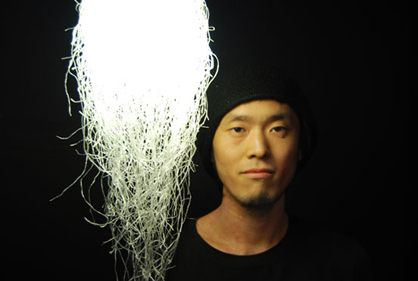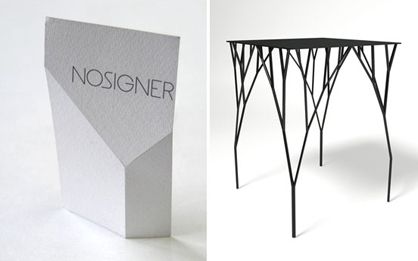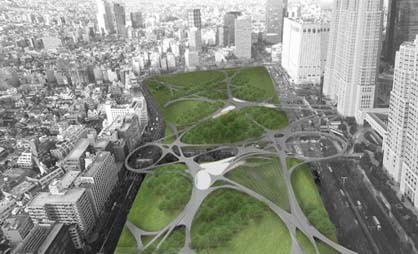Nosigner
Texto por Nora Schmidt
Berlin, Alemania
03.01.08
The 26-year old, who does not wish to reveal his real name, presented his poetic furniture and object designs at 100%Design under his 'Nosigner' label.
"Do you want me to show you the best product in the fair. I've got it on me." My colleague took the business card of a Japanese architect out of his trouser pocket, squeezed it lightly between two fingers and then set it in front of me on the table. And of course we wanted to meet the designer of this tiny piece of architecture. The 26-year old, who does not wish to reveal his real name, presented his poetic furniture and object designs at 100%Design under his 'Nosigner' label, and turned out to be one of the highlights of the show.
Architonic: You originally studied architecture and your teachers were some of the best-known architects in Japan. Why don't you create architectural designs?
Nosigner: My attitude to architecture was very much influenced by a workshop "Archi TV" held by students from Tokyo and the Architectural Institute of Japan with Toyo Ito, Kazuyo Sejima and others as guests. I was representative of the workshop. We dealt with the relationship between the human dimension and architecture. It became clear to me that our body is the centre of all design. For me everything which is outside the human body is architecture. And if you are not able to design small things like a salt shaker well, you will never manage to create designs on a large scale.
So is the work you are doing at the moment a kind of preparatory stage?
One day I'm sure that I'll work as an architect in the classical sense.
Can you rely on financial support when you have finished your studies in Japan?
(laughs) No, not in the least. Everything that I earn with my design work is invested in new designs. There's not much left over at the end.
At the moment you produce all your designs yourself.
I'm very happy that I can still work and design independently. I am currently working as a consultant to a furniture manufacturer in Tokushima. Tokushima is a relatively small town in the south of Japan. The town is well known for its traditional craftsmanship, but things are not looking good for the economy of the region because Japan is too expensive and many manufacturers have relocated their production to China. I would like to support the town, and in addition I have the opportunity to work with experienced craftsmen there.
In a world which is growing closer together, do the origins of a designer still play a significant role?
I have naturally been strongly influenced by my origins. Japan has some wonderful traditions and it would be a shame if these were lost. My design Sumi for example, is a traditional lunchbox from the Tokushima region. It has been made with local craftsmanship. With my design I want to remind people about these customs.
What differentiates Japanese design from European design?
Naturally I can only speak from my own perspective, but the way I experience international design I get the impression that European designers have an entirely different approach. Japanese design often has a core, a deep significance which is almost more important than the surface.
(After some thought) In order to put it in visual terms: if you want to display a circle, a European would draw a circular line. For Europeans the line and the area which is contained inside the line are the relevant elements which create the form. A Japanese, on the other hand, would draw a dot and then draw the circle around this dot. The circle can be large or small, but it always has the same central point. This point is the heart, the important element which is encircled by the line. This density of significance makes Japanese design difficult to adapt.
To what extent does this approach show itself in your design?
It is important for me to be aware of where my design is really coming from. Nature inspires me with its perfection. In fact I don't really regard myself as a designer. In the last analysis I do nothing in my design but implement natural shapes and laws. Arborism is the design of a table which illustrates this approach. The structure of the table's legs follows the fractal algorithm which shapes the natural growth of a tree's branches.
(After some thought) Perhaps this is why I am reluctant to sign my designs with my own name, because all I'm really doing is copying the logic of nature.
Baubiologue, 2004, selescted as one of the twelve best diploma projects in Japan





